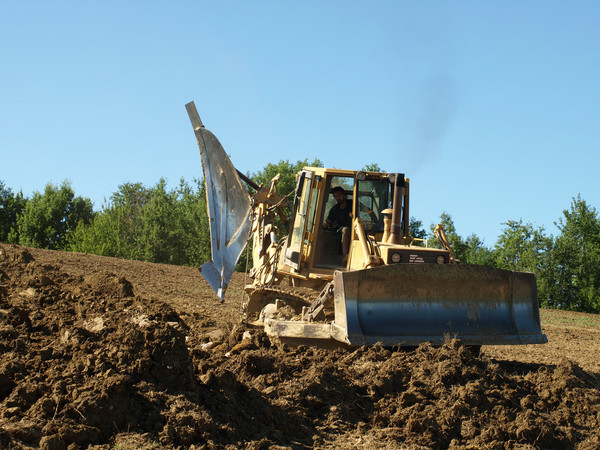
The bulldozer at work in agriculture
A dozer can turn out to be an efficient machine in difficult work conditions which stretch a tractor to its limits. The dozer is marketed today with various configurations and differing technological solutions to guarantee high performance in all operating conditions to make even the most demanding terrains production
The agricultural tractor is extremely versatile and put to good use for energy-intensive operations such as seeding and forage harvesting as well as much more demanding work such as earthmoving. For any sort of difficulty the traditional wheeled tractor can ensure great efficiency thanks to the adaptability of the machine to various operating conditions by modifying traction, varying tire pressure or mounting different tire models, and changing the weight of the machine by altering ballast. The farm tractor is a highly evolved machine which usually features a weight/power ratio of about 40 kg/hp, a value sufficient for such extremely demanding operations such as ploughing and subsoiling.
The problem of adherence
Precisely in these conditions as well as for the use of a big leveling blade, the factor limiting performance is not so much the power the engine makes available but the adherence, that is, what is produced by the weight on the drive wheels for determining the adhesion coefficient as a function of powered wheel slip on the surface of the soil. In general, for wheeled tractors the adherence coefficient varies from 0.4 for seedbeds to 0.65 for unpaved roads; for tracks these values increase by some 20%, thus from 0.5 to 0.8, so it is clear that weight being equal, a tracked machine will be capable of gaining greater adherence than a wheeled one and would thus able to tow implements which weigh more.
If great traction is needed, the propulsion components will begin progressive slipping to the point the forward advance of the vehicle is nullified. In this case, “give it gas” is not only useless but even cause damage so what is required is diminishing the force of traction, by raising the plow, for example, or increasing the weight of adherence. In farming, this can happen when operating deep break-up ploughing for planting vineyards and orchards or breaking up considerable quantities of ground for arranging the land.
The role of the dozer
In these limited circumstances when a conventional tractor is not up to the job there will have to be recourse to other means for other operations like the dozer, which features a weight/power ratio more than double, 90-100 kg/hp. Moreover, thanks to the tracks, the adhesion coefficient on traditional farmlands is considerably increased so that power used being equal, as well as fuel consumption, these heavy machines are capable of providing much superior traction even when taking into account that most of these machines mount hydrostatic or mixed hydrostatic-mechanical transmissions with performance which is slightly below that of typical agricultural transmissions.
For this reason, for land which is very difficult to work, as in the lower Ferrarese area, the use of dozers for ploughing is fairly widespread, though tracked tractors of a certain size, such as the Challenger and the Quadtrac, have come along recently.
Dozers, in fact, are used almost exclusively for ploughing and rarely for finishing or seeding so the return on an investment in a new machine would take too long a time. This means that most of the dozers put to work in agriculture are machines which have been picked up on the used machinery market at a lower price.
The use of the dozer can lead to financial benefits even where an agricultural tractor could be deployed, though this would involve considerable wear on the tires and gears due to extremely hard ground and/or ground containing particle sizes larger than 2 mm. Also, due to the increasingly frequent use of engine which have been “hopped up” in various ways, taking them beyond the manufacturer’s certified hp, there is the risk of a transmission breakdown if used for great loads at low speeds.
Useful also on ground giving way
The dozer shows its superiority also in operations on ground which is giving way due to excess humidity. Especially for finishing work or seeding, the dozer makes it possible to get into the field extremely early, after heavy rainfall, for example. In fact, through the weight of a dozer is much greater than that of a comparable tractor, the distribution of weight on the tracks on the surface exerts much less average pressure on the soil to allow the machine to float and thus limit the phenomenon of compacting the soil.
Operational limitations
The advantages described should have led to the massive distribution of dozers in agriculture. But in real conditions, any tracked machine presents considerable problems which must be solved. The first one is travel on public roads. Moreover, the practice of taking a curve is to put the machine in neutral resulting in a sharp drop in traction, which is actually halved, so the machine is no longer lined up on a longitudinal axis but shifts laterally to correspond to the driving track. It must also be considered that these conditions become more or less identical when, while driving straight ahead, a single track is suspended by running over a big rock, for example. And finally, for increasing the general level of safety, it is a good idea for this machine with considerable tonnage to be driven by expert personnel for operations which are purely agricultural because, though the machine is usually slower and more stable than a wheeled tractor, the use of a dozer can create dangerous operational conditions which are difficult to foresee and manage by drivers used to driving vehicles which are not propelled by tracks.







